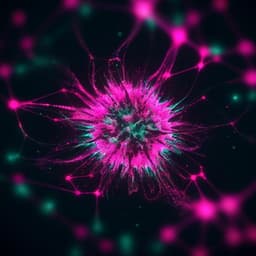
Medicine and Health
Ultrasmall copper-based nanoparticles for reactive oxygen species scavenging and alleviation of inflammation related diseases
T. Liu, B. Xiao, et al.
Discover the groundbreaking potential of ultrasmall Cu₅₄₀ nanoparticles (Cu₅₄₀ USNPs) as innovative nanozymes that mimic enzymes to combat oxidative stress-related diseases. This promising research by Tengfei Liu, Bowen Xiao, Fei Xiang, Jianglin Tan, Zhuo Chen, Xiaorong Zhang, Chengzhou Wu, Zhengwei Mao, Gaoxing Luo, Xiaoyuan Chen, and Jun Deng sheds light on their remarkable ROS scavenging abilities and their implications for treating acute injuries and enhancing wound healing.
~3 min • Beginner • English
Introduction
Excessive and uncontrolled inflammation contributes to diseases such as cardiovascular disease, hepatitis, nephritis, and impaired wound healing. Inflammation is tightly linked to oxidative stress; overproduced reactive oxygen species (ROS) aggravate tissue injury and drive chronic inflammation. Pharmacologic antioxidants like N-acetylcysteine show limited efficacy due to poor bioavailability and stability. Nanomedicine offers new routes for ROS clearance. An ideal therapeutic nanozyme would combine high, broad-spectrum ROS scavenging (CAT, SOD, GPx-like), stability in pathological environments, and rapid body clearance for safety. Ultrasmall nanoparticles (<5.5 nm hydrodynamic size) are attractive because of high catalytic surface area and renal clearance capability. Copper, an essential element in several enzymes (e.g., Cu-Zn SOD), motivates copper-based nanomaterials for ROS scavenging. Metallic Cu nanoparticles can catalytically remove H2O2 and O2−, whereas Cu2O can inactivate H2O2 and •OH. The authors hypothesized that combining Cu and Cu2O in ultrasmall particles would yield broader-spectrum enzymatic mimicry, higher catalytic activity, and improved stability, enabling effective therapy for ROS-related diseases.
Literature Review
Previous nano-antioxidants include carbon, ceria, platinum, redox polymers, and polyphenol nanoparticles. Ultrasmall nanomaterials have shown preferential renal uptake and efficacy in AKI (e.g., melanin-based, molybdenum-based nanoclusters, DNA origami structures). Cu-TCPP MOF nanodots mimic SOD but with lower relative activity. However, many reported systems face challenges of relatively low catalytic efficiency and/or high cost, hindering translation. Given copper’s role in natural enzymes and the complementary activities of Cu and Cu2O, a mixed Cu/Cu2O ultrasmall system may provide broad-spectrum, high-efficiency ROS scavenging with simple, scalable synthesis.
Methodology
Synthesis: Cu5.4O ultrasmall nanoparticles (USNPs) were synthesized via a green, rapid, one-step aqueous method. A 10 mM CuCl2 solution (50 mL) was stirred at 80 °C, followed by slow addition of 100 mM L-ascorbic acid (50 mL). The pH was adjusted to 8.0–9.0 with 1 M NaOH, and the mixture maintained at 80 °C for 12 h. Aggregates were removed by centrifugation; the supernatant was dialyzed (10 kDa cutoff) for 2 days and concentrated. Reaction parameters (Cu2+/AA ratio, temperature, time) were optimized for uniform size and activity; Cu2+/AA = 1:10 was adopted.
Characterization: TEM assessed morphology and core size (3.5–4.0 nm). DLS measured hydrodynamic diameter (~4.5 nm). XRD identified phases (Cu0 and Cu2O). X-ray Auger and XPS (Cu 2p) quantified composition (Cu:Cu2O ≈ 3:4 by mass). Stability in media, FBS, and serum was evaluated. Surface ligands were exchanged with HS-PEG-OH to test the role of ascorbate coating.
In vitro ROS scavenging: H2O2 removal was quantified with a peroxide detection kit (405 nm). •OH scavenging employed TMB oxidation (652 nm) and EPR with DMPO. Superoxide (O2−) scavenging used a WST-1/XO assay (450 nm). ABTS radical cation assay assessed general radical scavenging (734 nm). Enzyme-mimicking activities: CAT-like activity was measured by prevention of TPA hydroxylation and monitored by fluorescence (excitation/emission 315/425 nm), kinetics analyzed by Michaelis–Menten and Lineweaver–Burk. SOD-like activity was assessed via WST-1 formazan formation and EPR. GPx-like activity was evaluated by monitoring GSH oxidation with DTNB (412 nm). Stability tests evaluated activity across pH/temperature and recyclability across cycles. XPS tracked oxidation state pre/post H2O2.
Cell studies: HEK293 cells were used to model renal tubular susceptibility to oxidative stress. Cells were pretreated with Cu5.4O (0–50 ng mL−1), then challenged with H2O2 (250 µM). Intracellular ROS was measured by DCFH-DA staining (confocal imaging and flow cytometry). Viability (CCK-8), apoptosis/necrosis (Annexin V-FITC/PI flow cytometry), and subcellular localization (TEM for mitochondria/phagosomes) were assessed.
Biocompatibility: Cytotoxicity (0–200 ng mL−1; 24–48 h) and hemolysis (50–5000 ng mL−1) were measured. In vivo, healthy BALB/c mice received 4 µg kg−1 i.v. single-dose or daily for 7 days. Histopathology (H&E) of heart, liver, spleen, lung, kidney; serum cytokines (IL-6, TNF-α); liver/kidney function (ALT, AST, BUN, CRE); complete blood counts were evaluated at 1 and 30 days (single dose) and after repeated dosing. ICP-AES and TEM quantified organ accumulation after repeated dosing.
Pharmacokinetics and biodistribution: AKI mice received 2 µg kg−1 i.v. Blood was sampled up to 72 h for ICP-AES and fitted to a two-compartment model (half-lives). Biodistribution (%ID g−1) at 24 h post-injection was quantified in major organs. Excretion (urine, feces) was measured over 48 h. TEM identified particles in urine and renal structures (GBM, urinary space, tubular cilia).
Therapeutic efficacy studies: Glycerol-induced AKI model: mice received 2 µg kg−1 Cu5.4O i.v. 2 h post-injury (PBS control; NAC controls at 8, 40, 160 mg kg−1). Outcomes: survival (14 days), body weight (24 h), renal function (BUN, CRE), renal histology (casts), tissue ROS (DHE staining), SOD activity, biomarkers (KIM-1, HO-1). Cisplatin-induced AKI model: therapeutic efficacy assessed similarly.
Other disease models: Acetaminophen-induced acute liver injury (APAP 300 mg kg−1); Cu5.4O 6 µg kg−1 i.v. 2 h later; ALT/AST and liver histology at 24 h. Diabetic wound model (STZ-induced): full-thickness dorsal wounds treated topically with Cu5.4O (20 µL of 400 ng mL−1) on days 0,1,4,7,9,15; wound area tracking and histology (regenerated epidermis length, granulation thickness).
Mechanistic studies: Renal transcriptomics (RNA-seq) in AKI mice (PBS vs Cu5.4O, n=5/group) with DEG analysis, KEGG pathway enrichment (MAPK, TNF, glutathione metabolism), STRING PPI. qRT-PCR confirmed antioxidant gene expression (SODs, GPXs, CAT). Western blot probed NF-κB p65 and IκB-α phosphorylation. ELISAs quantified TNF-α and IL-1β in serum and kidney.
Key Findings
- Composition/size: Uniform ultrasmall Cu/Cu2O nanoparticles (~3.5–4.0 nm core; ~4.5 nm hydrodynamic), mixed phases with Cu:Cu2O ≈ 3:4 by mass.
- Broad-spectrum ROS scavenging at ultralow doses: ~80% H2O2 (2 mM) removed by 200 ng mL−1; ~50% O2− reduced at 150 ng mL−1; >80% •OH scavenged at 150 ng mL−1; ABTS radicals reduced by >89% at 150 ng mL−1. Working cellular protective concentration as low as 25 ng mL−1 (in vitro) and 2 µg kg−1 (in vivo AKI), 2–3 orders of magnitude lower than many metal-based nano-antioxidants and ~2000-fold more efficient than vitamin C for H2O2 scavenging under tested conditions.
- Enzyme-mimicking activity: CAT-like kinetics followed Michaelis–Menten; Km = 0.065 mM (vs natural CAT 0.134 mM), Vmax = 3.92 × 10−6 M s−1 (assay conditions). SOD-like EC50 = 191.4 ng mL−1 (~21.7% of native Cu/Zn SOD activity; higher than reported Cu-TCPP MOF nanodots). GPx-like activity observed via GSH oxidation. Activities were stable across pH/temperature variations and recyclable across catalytic cycles.
- Mechanism control: Replacing surface ascorbate with HS-PEG-OH did not diminish H2O2 scavenging, indicating intrinsic nanoparticle-driven activity.
- Cellular protection: In HEK293 cells challenged with 250 µM H2O2, pretreatment with 25 ng mL−1 Cu5.4O fully preserved viability, markedly reduced intracellular ROS (DCFH-DA), and decreased apoptosis/necrosis (Annexin V/PI). Particles localized to mitochondria and phagosomes.
- Biocompatibility: No significant cytotoxicity up to 200 ng mL−1 in vitro (48 h). Hemolysis <5% even at 500 ng mL−1. In healthy mice (4 µg kg−1 i.v.), no organ histopathology at 1 and 30 days; no elevation in serum IL-6/TNF-α, ALT/AST, BUN/CRE; normal hematology. Repeated dosing (4 µg kg−1 daily ×7) showed organ accumulation primarily in liver and kidney (≈7.9 %ID g−1 each) but no observable toxicity; TEM confirmed presence in tissues.
- Pharmacokinetics/clearance: Two-compartment model with terminal half-lives ~0.77 h (central) and ~71.2 h (peripheral). In AKI mice at 24 h, kidney showed highest accumulation (~4.4 %ID g−1). ~70% of injected dose excreted within 48 h (≈60% urine, 10% feces). TEM detected particles in urine and kidney GBM/urinary space/tubular cilia, consistent with renal filtration (size ~4.5 nm < ~5.5 nm GBM threshold).
- Therapeutic efficacy in AKI: In glycerol-induced AKI, 2 µg kg−1 Cu5.4O led to 100% survival beyond 14 days vs ~10% survival in controls. Body weight recovered; BUN and CRE normalized to levels indistinguishable from healthy mice (P > 0.05) and significantly better than controls (P < 0.001). Fewer tubular casts on histology. Efficacy comparable to high-dose NAC (160 mg kg−1). Renal superoxide levels reduced to normal; SOD activity maintained; injury biomarkers KIM-1 and HO-1 reduced (P < 0.001).
- Additional disease models: In APAP-induced acute liver injury, Cu5.4O (6 µg kg−1) significantly lowered ALT/AST (P < 0.001) and improved liver histology. In diabetic wound model, topical Cu5.4O accelerated wound closure on days 4, 7, 9, and 15 (P < 0.01), increased regenerated epidermis length and granulation tissue thickness.
- Mechanistic insights: Transcriptomics revealed downregulation of MAPK and TNF signaling, upregulation of glutathione metabolism. qRT-PCR showed increased expression of antioxidant genes (SOD1/2/3, GPX1/3/4/6, CAT). Western blots indicated reduced phosphorylation of NF-κB p65 and IκB-α. ELISA showed decreased TNF-α and IL-1β in serum and kidney. Genes associated with tissue repair (FGF10, HGF, NOTCH1, WNT7A) were upregulated.
Discussion
The study demonstrates that ultrasmall mixed-phase copper nanoparticles (Cu/Cu2O) can intrinsically mimic multiple antioxidant enzymes (CAT, SOD, GPx), enabling broad-spectrum and highly efficient ROS scavenging. Their ultrasmall hydrodynamic size yields high catalytic site exposure and allows glomerular filtration, achieving both strong therapeutic effects and rapid clearance for safety. At doses orders of magnitude lower than conventional nano-antioxidants, Cu5.4O USNPs protect cells from oxidative injury, normalize renal function, and improve survival in AKI. Mechanistically, ROS reduction preserves endogenous antioxidant capacity (SOD activity), suppresses pro-inflammatory signaling (MAPK, TNF, NF-κB), lowers inflammatory cytokines (TNF-α, IL-1β), and reduces tissue injury biomarkers (KIM-1, HO-1). The nanoparticles also facilitate tissue repair, accelerating wound healing and ameliorating acute liver injury. Collectively, these findings address the need for potent, biocompatible, and clearable nanozymes to treat ROS-driven inflammation across multiple disease contexts.
Conclusion
Cu5.4O ultrasmall nanoparticles provide a simple, scalable, and effective nanozyme platform with intrinsic multienzyme mimicry, broad-spectrum ROS scavenging, and excellent biocompatibility with rapid renal clearance. They achieve protective effects at ultralow doses in vitro and in vivo, yielding marked therapeutic benefits in AKI, acute liver injury, and diabetic wound healing, while modulating oxidative stress and inflammatory pathways. These results position Cu-based ultrasmall nanozymes as promising antioxidants for diverse ROS-related diseases. Future work should include comprehensive long-term safety and metabolism studies, evaluation across additional large-animal models, optimization of dosing and administration routes (including topical and systemic), mechanistic dissection of active surface sites and redox cycling in vivo, and steps toward clinical translation and manufacturing under GMP.
Limitations
- Species and model limitations: Efficacy and safety were demonstrated in mouse models (glycerol- and cisplatin-induced AKI, APAP-induced liver injury, STZ-diabetic wound). Translation to humans requires additional large-animal studies.
- Long-term fate: While rapid renal clearance and 30-day histology were favorable, very long-term biodistribution, potential copper accumulation, and immunogenicity beyond the tested windows were not fully assessed.
- Dose range and exposure: Therapeutic windows, repeated-dose regimens, and exposure in chronic disease settings need further exploration.
- Mechanistic resolution: Although pathway analyses (MAPK, TNF, NF-κB) and antioxidant gene upregulation were shown, the precise catalytic active sites, copper valence cycling in vivo, and interactions with protein corona in human plasma warrant deeper investigation.
- Manufacturing and stability: While synthesis is simple, scale-up parameters, batch-to-batch reproducibility, and storage stability under clinical conditions were not detailed.
Related Publications
Explore these studies to deepen your understanding of the subject.







